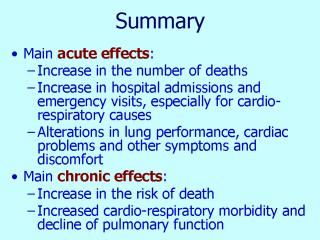| front |1 |2 |3 |4 |5 |6 |7 |8 |9 |10 |11 |12 |13 |14 |15 |16 |17 |18 |19 |20 |21 |22 |23 |24 |25 |26 |27 |28 |29 |30 |31 |32 |33 |34 |35 |review |
 |
Today, decades after some of the
most important episodes, air pollution continues to be one of the major issues of
Environment and Public Health. Epidemiology studies in a considerably great number of
places have established an association between increases in air pollutants and increases
in symptoms, diseases, emergency visits, hospital admissions and deaths. Evidences are very consistent and showing an independent effect for particles and ozone. Other pollutants like CO, NO2 or SO2 could have an independent or an additive effect, and further investigation is needed to elucidate their role. The main short term effects of air pollution on health range from an increase in the number of deaths, hospital admissions and emergency visits, especially for respiratory and cardiovascular causes to alterations in lung performance, cardiac problems and other symptoms and discomfort. In the same way, chronic effects related with long term exposure have been showed. The increase in the risk of death through chronic exposure to pollution is estimated as few times greater than risk due to acute exposure. Chronic exposure has also been associated with increased cardio-respiratory morbidity and with decline of pulmonary function, both among children and adults. Individual follow-up studies indicate a far from negligible effect of long term exposure on life expectancy. In fact their impact on mortality could be several times that of time series studies. |